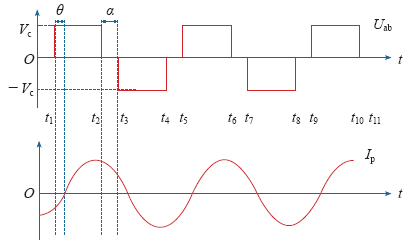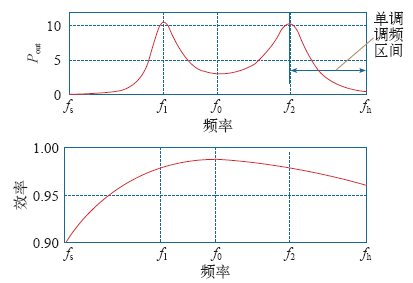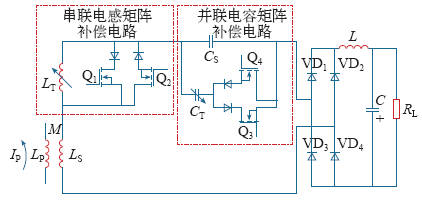1 引言
无线电能传输技术(Wireless Power Transfer,WPT),主要包括基于磁感应耦合式的无线电能传输(Inductive Coupling Wireless Power Transfer Technology,ICPT)和磁谐振耦合式无线电能传输(Magnetic Resonance Coupling,MRC)。在系统工作时,无线电能传输单元参数的变化如谐振电容的衰减、磁性材料对于电感参数的影响、传输距离的变化、负载参数的轻微改变甚至是外界环境如温度的变化,将引起系统参数的变化,进而导致WPT系统输出电压/电流发生改变。在实际应用中,一般采用系统输出控制策略,实现无线电能传输系统可控输出[1]。
无线电能传输系统与传统的电力电子设备有所不同,通过电磁耦合作用,实现电能在原边线圈(或线圈组)和副边线圈(或线圈组)气隙间的传输,系统结构如图1所示。气隙间不存在电气连接,且原、副边侧控制单元相互独立,存在一定空间距离,难以在原、副边侧之间构成导体的反馈回路,因此传统的由导线直接反馈电信号构成闭环系统不适合WPT控制系统。实际系统中,WPT系统的原边控制器与副边控制器之间往往采用无线方式进行通信,如射频、蓝牙和红外等。但也会带来一些问题:一方面,采用无线通信进行信息传输会带来反馈信息的传输延时;另一方面,系统工作时电磁环境复杂,导致无线通信数据的速率低、误码率高等问题,难以将无线通信的信息数据作为控制的唯一依据。
图1
目前常用的控制方式包括半控式和全控式,半控式仅在原边或副边进行信号的检测和控制,原、副边控制器无信息通信,系统中不存在无线通信环节,该方法结构简单,但系统控制输出性能较差。全控式通过无线方式实现原、副边检测信号的通信,控制器可综合原、副边的检测信息进行系统输出控制,输出控制性能较好[2]。
无线电能传输系统的控制策略是无线电能传输系统走向实用化的一项关键技术,目前常用的无线电能传输按照控制对象来分主要包括对原边或者副边的DC-DC环节的控制、高频逆变器恒频/变频控制及基于谐振补偿网络参数控制等。
2 WPT系统理论分析
一般来说,ICPT系统采用两线圈结构,根据系统中谐振补偿电路拓扑种类,可以分为SS、SP、PS和PP四种类型。根据不同的应用需求,为了将ICPT系统与逆变器和负载进行匹配,ICPT系统一般还需要增加阻抗匹配网络,如常用的“T”型或“Π”型阻抗匹配网络。
图2中四种拓扑结构具有一定等效性,以SS系统拓扑为例进行分析,可得ICPT电路方程
图2

系统功率输出

图3
根据电路理论,可建立MRC系统方程如下

其中

从式(1)~式(4)可以看出,WPT系统输出功率/电压/电流,与逆变器输出电压、系统电路参数、频率等参数有关,因此可通过对以上参数的控制实现WPT系统输出控制。
3 输出控制方法
3.1 基于DC-DC变换输出控制技术
图4
一般来说,在原边加入DC-DC环节能线性调节输出电压,但在副边加入DC-DC变换环节会改变等效的负载电阻,使无线电能传输系统的非线性更加复杂,所以在实际应用中,使用最多的是在原边加入DC-DC环节。常见的DC-DC变换电路有BUCK、BOOST、CUK和BUCK-BOOST变换电路。系统输出功率为如式(5)所示,其中逆变器输入阻抗为ZDC = RDC + jXDC,η为逆变器到负载的工作效率。

基于DC-DC的输出控制方法是一种双闭环WPT系统控制方式。首先,根据WPT系统输出电压的检测信号,对DC-DC输出电压进行控制,实现WPT系统输出的闭环控制;其次,由于无线通信通信延时较大,以及极端电磁环境下可靠性降低问题,需要在系统控制时,引入逆变器的输入电流Iin构成电流闭环控制,从而实现WPT系统控制的电压电流双闭环控制。
基于DC-DC变换的输出控制技术,具有调功范围宽、控制可靠且控制精度较高等优点。但该控制方法增加了一级电能变换,导致系统的整体效率降低,且增加系统的体积和成本。
3.2 基于高频逆变器恒频控制技术
针对基于DC-DC变换器存在的问题,学者研究基于高频逆变器调功的控制方法。
图5
PWM控制方式中开关管驱动脉冲如图6a所示,处于对角线的两个开关管的驱动波形完全相同(Q1和Q4,Q2和Q3),且4个开关管的占空比完全相同。该方式最大缺点在于,t2和t4时刻4个开关管均处于关断状态,此时原边线圈电流缺少完整的电流通道,产生较大的电磁干扰,且当PWM占空比较小时问题更为严重。
图6
图6b所示为高频逆变器移相控制驱动脉冲波形,所有开关管占空比均为50%,且同一桥臂上下开关管互补导通。移相控制方式采用超前臂和滞后臂之间的相位差来调节逆变器的输出电压和输出电流。
在时间t1〜t2段,Q1和Q4管开通,直流电源通过这两个开关管和原边电感形成电流回路,给无线电能传输系统注入电能;在t2〜t3段,Q2和Q4开通,原边电感Lp和原边谐振补偿电容Cp通过Q2,Q4,形成自由谐振回路;同样t3〜t4段,Q2,Q3管开通,直流电源通过这两个开关管给系统注入电能;t4〜t5段,Q1和Q3开通,系统自由谐振。
理想情况下,电压型移相全桥逆变器输出电压为矩形波,当Lp与Cp构成完全谐振网络时,逆变器输出的电流为正弦波,如图7所示。图中θ为逆变器后端等效负载的阻抗角,α为移相逆变器超前臂和滞后臂之间的相位差。通过调节相位差α调整逆变器输出电流的大小,进而控制WPT系统输出。
图7
通过移相控制策略来控制无线电能传输系统的输出功率不需要增加额外的硬件电路,当负载相对恒定时,可以采用移相方式调节输出功率,当负载发生变动时,如有多个二次侧接收线圈时,可以采用分段控制移相控制方式来控制系统输出[6]。
但由于逆变器输出电压会随着移相角α的增加会发生变化,逆变器的输出电流也会因此发生畸变,严重时将会导致系统不能正常工作,在这种情况下,现在常用的移相控制方式会结合谐振补偿网络参数控制策略或者改变系统的频率策略来使移相控制正常工作,但增加了系统的控制复杂度。
3.3 基于高频逆变器调频控制技术(PFM)
从前面分析可以看出,WPT系统传输功率与工作频率f密切相关。改变逆变器的工作频率f,系统的传输功率和传输效率都会发生改变,在系统传输效率相对稳定而系统输出功率随系统频率变化范围较大的系统中,可以直接采用PFM控制技术实现系统的输出调节[7]。
设计调频控制策略时,需要依据无线电能传输系统的频率特性选取工作频率范围。当系统处于欠耦合、临界耦合或过耦合状态时,均存在两个工作频率范围可以进行调功。如图8所示,系统处于过耦合状态时,存在2个功率最大传输频率,即系统的输出功率呈现双峰特性,但系统的传输效率值却变化不大。据此可以在(fs,f1)和(f2,fh)两个单调频率区间内进行功率的调节,图中选择在(f2,fh)这个单调区间进行调频控制。
图8
基于PFM的控制方式简单可靠,易于实现,但由于对于固定的系统,通过调节频率来控制输出功率非线性性很强,而且当调频范围过宽时容易造成系统的不稳定。所以该方法常用在调节频率范围不大的系统中[8]。
3.4 基于谐振补偿网络的控制技术
图9
基于谐振补偿网络的输出控制方法,通过电路补偿参数的调整能够有效调节WPT系统输出,但也存在着系统体积增大,成本高的问题,而且功率调节非线性度高,控制精度并不高。也有学者通过补偿谐振网络方法,增加系统的频率稳定性,实现系统最大能量传输[12]。
3.5 其他控制方法
除了以上几种控制方法外,还有副边短路解耦控制策略、基于磁放大器饱和电感控制策略、脉冲密度控制策略以及调频与移相组合控制策略等多种控制方式。
基于磁放大的饱和电感控制策略和相控电感控制策略类似,所不同的是相控电感的控制策略是通过改变谐振补偿网络的导通角来改变谐振网络的参数,而基于磁放大的饱和电感控制策略是通过给线圈通入直流电流控制电感磁芯的饱和程度来控制谐振电感的值[14]。
脉冲密度控制方式,也称能量注入控制方式,通过周期性控制PWM脉冲的有无,实现输出功率的调节[15]。但该控制方式是一种分级控制,控制精度较低。
调频与移相组合控制策略是综合考虑了调频控制策略和移相控制策略的优缺点,以移相控制为主、调频控制为辅的一种输出控制策略。
3.6 几种输出控制策略的对比
通过以上分析,我们可以得到各种WPT输出控制方法的特点,如下表所示,可以根据实际的具体工作场合和应用要求选择合适的控制策略。
表 输出控制策略的优缺点对比
Tab.
| 控制策略 | 优点 | 缺点 | 适用范围 |
|---|---|---|---|
| DC-DC 控制 | 控制精度高,调节范围宽 | 系统效率低,体积大,成本高 | 对控制精度要求较高的场合 |
| 移相控制 | 不需增加额外的电路,成本低 | 控制复杂,谐振电压波形容易畸变,增大EMI | 中小功率系统 |
| 谐振补偿 网络控制 | 能始终得到最大传输功率 | 系统体积大,控制精度低 | 功率及频率稳定性要求高的场合 |
| 调频控制 策略 | 成本低,控制简单 | 非线性强,调功范围窄 | 调节功率范围比较窄的系统中 |
4 结论
无线电能传输系统的输出功率易受参数和环境变化的影响,输出控制方法在无线电能传输系统的实际应用中非常重要。分析了无线电能传输系统常用的控制系统框图,以WPT系统和MRC系统为主要研究对象,分析了其统一的等效电路模型条件,在此基础上分析了无线电能传输系统的各种输出控制方法,并总结了其优缺点。
参考文献
磁耦合谐振式无线电能传输技术新进展
[J].近些年,无线电能传输技术受到了越来越广泛的关注。作为一种中等距离无线电能传输技术,自从美国麻省理工学院于2007年发表其研究成果后,磁耦合谐振式无线电能传输技术就成为了研究热点问题。该文在对无线电能传输技术进行总体介绍的基础上,主要对磁耦合谐振式无线电能传输技术进行概括论述。首先分析了磁耦合谐振式无线电能传输技术的基本结构和工作原理,介绍了目前运用于分析该技术的主要理论;接着对该技术目前的传输水平和热点问题进行了分类阐释,主要分为传输特性、新材料的应用、干扰问题和实际应用,介绍了目前的研究现状;最后在当前研究热点问题的基础之上,对该技术有待研究的问题以及发展趋势进行了展望。
New progress of magnetically-coupled resonant wireless power transfer technology
[J].近些年,无线电能传输技术受到了越来越广泛的关注。作为一种中等距离无线电能传输技术,自从美国麻省理工学院于2007年发表其研究成果后,磁耦合谐振式无线电能传输技术就成为了研究热点问题。该文在对无线电能传输技术进行总体介绍的基础上,主要对磁耦合谐振式无线电能传输技术进行概括论述。首先分析了磁耦合谐振式无线电能传输技术的基本结构和工作原理,介绍了目前运用于分析该技术的主要理论;接着对该技术目前的传输水平和热点问题进行了分类阐释,主要分为传输特性、新材料的应用、干扰问题和实际应用,介绍了目前的研究现状;最后在当前研究热点问题的基础之上,对该技术有待研究的问题以及发展趋势进行了展望。
Comparative study on power conversion methods for wireless battery charging platform
[C].
Experimental demonstration of the equivalence of inductive and strongly coupled magnetic resonance wireless power transfer
[J].
Highly resonant power transfer
[C].
Robust control for an uncertain LCL resonant ICPT system using LMI method
[J].
DOI:10.1016/j.conengprac.2012.09.006
URL
[本文引用: 1]

Frequency drift has considerable adverse effects on the inductively coupled power transfer (ICPT) system such as decrease of transmission power and distance, EMC interference, system detuning and performance deterioration, and deviated operation from system design requirements endangering the stability so that robust control of ICPT system remains an open applied research problem. This article presents a relevant uncertain model for the LCL resonant ICPT system first via the generalized state-space averaging and the LFT methods, and then a solution to H, controller synthesis by making use of the LMI method. The control design is first tested by computer simulation and thereafter verified by means of physical experiments. The results show that by applying the proposed Ho, synthesis controller the overall system has achieved both predetermined robustness with respect to the norm-bounded load and frequency uncertainties and dynamically tracking the voltage references according to the actual power demands. (C) 2012 Elsevier Ltd.
On piecewise control method of contactless power transmission system
[C].
Characterization and control of self-oscillating contactless resonant converter with fixed voltage gain
[C].
Automated frequency tracking system for efficient mid-range magnetic resonance wireless power transfer
[J].
DOI:10.1002/mop.26858
URL
[本文引用: 1]

An automated frequency tracking system is implemented for an efficient mid-range magnetic resonance wireless power transfer based on an analysis of a wireless power link consisting of transmitting and receiving resonators placed in a strong coupling region.The proposed tracking system is designed to maintain a power transfer efficiency of more than 70% for any transfer distance range by directly monitoring the efficiency via out-band communication. The advantage of the proposed system over other frequency tracking schemes is that the performance of the resonators and power amplifier can be applied to the tracking algorithm. (C) 2012 Wiley Periodicals, Inc. Microwave Opt Technol Lett 54:14231426, 2012; View this article online at wileyonlinelibrary.com. DOI 10.1002/mop.26858
A dynamically on-off controlled resonant converter designed for coalmining battery charging applications
[C].
A variable inductor based tuning method for ICPT pickups
[C].
Transfer efficiency optimal control of magnetic resonance coupled system of wireless power transfer based on frequency control
[J].
DOI:10.1007/s11431-011-4380-6
URL
[本文引用: 1]

In order to suppress the fast decrease of the transfer efficiency of magnetic resonance coupled wireless power transfer system (MRCWPTS) with distance increase, this paper investigates the impact factors of the system transfer efficiency and is, then formulates a new efficiency optimal control method based on frequency control. Based upon this control method two optimal control schemes are designed to achieve transfer efficiency control of the system. Simulations and experiments show that the proposed efficiency optimal control method can effectively stabilize the system transfer efficiency in a certain range so as to successfully solve the subtle issue of transfer efficiency variation with distance.
Achieving maximum power transfer of inductively coupled wireless power transfer system based on dynamic tuning control
[J].
DOI:10.1007/s11431-012-4847-0
URL
[本文引用: 1]

As an emerging research field, inductively coupled wireless power transfer (ICWPT) technology has attracted wide spread at-tention recently. In this paper, the maximum power transfer performances of four basic topologies labeled as SS, SP, PS and PP are investigated. By modeling the equivalent circuits of these topologies in high frequency (HF), the primary resonance compensation capacitances for maximum power transfer capability are deduced. It is found that these capacitances fluctuate with load resistance change, which is disadvantageous to SP, PS and PP topologies and an obstacle to their practical applications as well. To solve this problem, a phase controlled inductor circuit is proposed. By adjusting the triggering angle, the real-time dynamic tuning control can be achieved to guarantee maximum power transfer. Finally, simulations and experiments show that the proposed method is of great effectiveness and reliability to solve the issue of resonance compensation capacitance fluctuation with load change and to guarantee the flexible applications of all topologies.
新型无接触电能传输系统多负载解耦控制研究
[J].
Research on the decoupling control of contactless power transfer system with multiple loads
[J].
基于磁放大器的无接触充电电路研制
[J].
DOI:10.1016/j.exer.2019.107904
URL
PMID:31883460
[本文引用: 1]

This study was conducted to evaluate the impact of varying scleral material properties on the biomechanical response of the cornea under air-puff induced deformation. Twenty pairs of human donor eyes were obtained for this study. One eye from each pair had its sclera stiffened using 4% glutaraldehyde, while the fellow eye served as control for uniaxial strip testing. The whole globes were mounted in a rigid holder and intraocular pressure (IOP) was set using a saline column. Dynamic corneal response parameters were measured before and after scleral stiffening using the CorVis ST, a dynamic Scheimpflug analyzer. IOP was set to 10, 20, 30, and 40 mmHg, with at least 3 examinations performed at each pressure step. Uniaxial tensile testing data were fit to a neo-Hookean model to estimate the Young's modulus of treated and untreated sclera. Scleral Young's modulus was found to be significantly correlated with several response parameters, including Highest Concavity Deformation Amplitude, Peak Distance, Highest Concavity Radius, and Stiffness Parameter-Highest Concavity (SP-HC). The interaction between IOP and scleral Young's modulus was significantly correlated only to HC Deformation Amplitude. There were significant increases in SP-HC after scleral stiffening at multiple levels of IOP, while no significant difference was observed in the corneal Stiffness Parameter - Applanation 1 (SP-A1) at any level of IOP. Scleral mechanical properties significantly influenced the corneal deformation response to an air-puff. The stiffer the sclera, the greater the constraining effect on corneal deformation resulting in lower displaced amplitude. This may have important clinical implications and suggests that both corneal and scleral material properties contribute to the observed corneal response in air-puff induced deformation.
Design of contactless charging circuit based on magnetic amplifier
[J].
DOI:10.1016/j.exer.2019.107904
URL
PMID:31883460
[本文引用: 1]

This study was conducted to evaluate the impact of varying scleral material properties on the biomechanical response of the cornea under air-puff induced deformation. Twenty pairs of human donor eyes were obtained for this study. One eye from each pair had its sclera stiffened using 4% glutaraldehyde, while the fellow eye served as control for uniaxial strip testing. The whole globes were mounted in a rigid holder and intraocular pressure (IOP) was set using a saline column. Dynamic corneal response parameters were measured before and after scleral stiffening using the CorVis ST, a dynamic Scheimpflug analyzer. IOP was set to 10, 20, 30, and 40 mmHg, with at least 3 examinations performed at each pressure step. Uniaxial tensile testing data were fit to a neo-Hookean model to estimate the Young's modulus of treated and untreated sclera. Scleral Young's modulus was found to be significantly correlated with several response parameters, including Highest Concavity Deformation Amplitude, Peak Distance, Highest Concavity Radius, and Stiffness Parameter-Highest Concavity (SP-HC). The interaction between IOP and scleral Young's modulus was significantly correlated only to HC Deformation Amplitude. There were significant increases in SP-HC after scleral stiffening at multiple levels of IOP, while no significant difference was observed in the corneal Stiffness Parameter - Applanation 1 (SP-A1) at any level of IOP. Scleral mechanical properties significantly influenced the corneal deformation response to an air-puff. The stiffer the sclera, the greater the constraining effect on corneal deformation resulting in lower displaced amplitude. This may have important clinical implications and suggests that both corneal and scleral material properties contribute to the observed corneal response in air-puff induced deformation.












